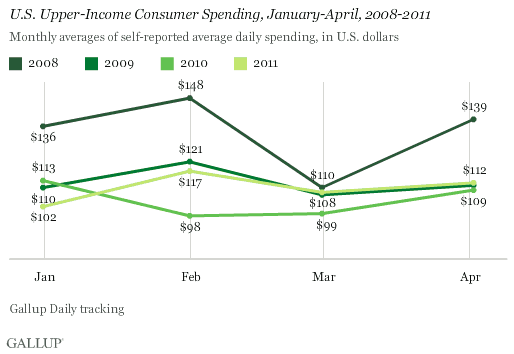PRINCETON, NJ -- U.S. consumers' self-reported daily spending in stores, restaurants, gas stations, and online averaged $65 per day in April, despite soaring food and energy prices. This is essentially the same as the $64 in March and on par with April 2010.

Consumer spending over the first four months of 2011 is virtually unchanged from the same period last year and in 2009. Nearly two years after economists declared the recession over, spending remains far below the pre-economic-crisis levels of early 2008.
Upper-Income Americans Not Spending More
Upper-income Americans (those making $90,000 or more annually) spent an average of $112 per day in April -- not much different from the $108 of March. While these Americans have the disposable income to spend more freely when they choose, they have not done so during the first four months of 2011. Instead, upper-income spending has been largely consistent with the depressed levels of 2009 and 2010.

Lower- and Middle-Income Spending No Different Than a Year Ago
Lower- and middle-income Americans' self-reported spending averaged $58 per day during April -- not much different from the $57 of March. This spending level also mirrors the $59 average of April a year ago.

Implications
Last year at this time, economic confidence was improving and the jobs picture was looking a little better. People were talking about "frugality fatigue." Retailers were all smiles as it seemed the upper-income consumer was poised to spend. May turned out to be a good month as spending soared.
This year, things are much different. Economic confidence is plunging. Gas prices are surging, as are food prices. Although job creation reached a post-recession high in April, it has been essentially flat for the past three months. Neither upper-income consumers nor their middle- and lower-income counterparts are spending more than they did a year ago.
So it seems unlikely that the nation's retailers will be able to match their May 2010 sales levels and, simultaneously, it is increasingly likely that the slowdown in economic growth during the first quarter will continue in the months ahead.
Gallup.com reports results from these indexes in daily, weekly, and monthly averages and in Gallup.com stories. Complete trend data are always available to view and export in the following charts:
Daily: Employment, Economic Confidence and Job Creation, Consumer Spending
Weekly: Employment, Economic Confidence, Job Creation, Consumer Spending
Read more about Gallup's economic measures.
View our economic release schedule.
Survey Methods
For Gallup Daily tracking, Gallup interviews approximately 1,000 national adults, aged 18 and older, each day The Gallup Job Creation Index results are based on a random sample of approximately 500 current full- and part-time employees each day.
National results for March are based on Gallup Daily tracking interviews with 14,503 adults conducted April 1-30, 2011. For this sample, one can say with 95% confidence that the maximum margin of sampling error is ±1 percentage point.
Interviews are conducted with respondents on landline telephones and cellular phones, with interviews conducted in Spanish for respondents who are primarily Spanish-speaking. Each sample includes a minimum quota of 400 cell phone respondents and 600 landline respondents per 1,000 national adults, with additional minimum quotas among landline respondents for gender within region. Landline telephone numbers are chosen at random among listed telephone numbers. Cell phone numbers are selected using random-digit-dial methods. Landline respondents are chosen at random within each household on the basis of which member had the most recent birthday.
Samples are weighted by gender, age, race, Hispanic ethnicity, education, region, adults in the household, and phone status (cell phone only/landline only/both, cell phone mostly, and having an unlisted landline number). Demographic weighting targets are based on the March 2010 Current Population Survey figures for the aged 18 and older non-institutionalized population living in U.S. telephone households. All reported margins of sampling error include the computed design effects for weighting and sample design.
In addition to sampling error, question wording and practical difficulties in conducting surveys can introduce error or bias into the findings of public opinion polls.
For more details on Gallup's polling methodology, visit www.gallup.com.
